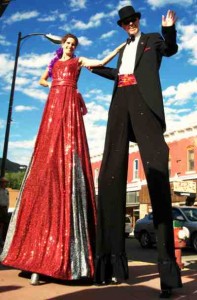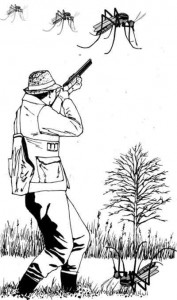Column by George Sibley
Medicine – August 2007 – Colorado Central Magazine
ANOTHER BEAUTIFUL HOT DAY here — what some would call droughty — as I try to weed around a few semi-coherent thoughts that seem to be growing like the stuff in the garden these days.
The gardens where I hang out this summer –one at the college and one at home — are growing so vigorously that we had to spend time killing plants. “Thinning” is the euphemism we use, but basically it’s the act of pulling up plants from groups that have succeeded too well.
From the little dotted lines of tiny seeds we dribbled into finger-scratched furrows a couple of months ago, we got this mini-jungle of lusty little plants elbowing and poking at each other for better places in the sun, and we had to go in like God wielding a plague and eliminate (in the case of the carrots) up to three- fourths of them. A task made less onerous for the thinner by the fact that a lot of it is edible, if small, very tender and good if you don’t mind the occasional crunch of a little dirt.
But thinning plants only engages a corner of the mind, so a lot of other thinking weedily proliferates to fill the space available. Thoughts proliferate in my mind like seedlings in the garden, and end up requiring some kind of thinning, which I handle by trying to unload things from my mind into yours. It’s similar to what we’ll probably be trying to do with the extra zucchinis pretty soon.
The thinning work lent itself to reflection on some related stories I’ve encountered recently in the pinko commie leftist magazines and websites I tend to feed on — all of them some variation on the title of one story that stuck in my mind: “This planet ain’t big enough for the 6,500,000,000 of us.” Stories about population, in other words. That story concluded, as I remember it, by suggesting that we might need “radical plans” to reduce global population. “Radical plans” is a phrase that lodges in one’s imagination like a fishbone in the throat.
One of the variant stories dealt with the loss of topsoil globally under the kind of intensive machine-driven agriculture we are imposing on the earth. It reminded my wandering mind of a rest stop on Interstate 80 in Iowa, where an obelisk eight or ten feet tall shows the layers of topsoil that have disappeared off of that farmland in the couple of centuries since farmers replaced foragers there.
Another essay discussed the demographic event due to happen this year: earth’s total urban population will surpass the total rural population, an ongoing global migration that concentrates poverty in sprawling slum-cities. The upside of this for the author, as I recall, was the access to medical facilities and education for those huddled masses –the medical facilities presumably keeping them alive, toward what end no one seems to know. Education — I recall from another article –at least seems to reduce the growth of population when it is made available to women, which many nations seem reluctant to do.
Yet another recent article laid the blame for much of this land-to-city migration on the World Trade Organization’s drive to open up nations to the subsidized products of agribusiness (primarily from the U.S.), which undermines local unsubsidized subsistence farmers with small surpluses to sell. Thus is NAFTA one of the chief causes of the current “illegal” Mexican immigration into the U.S.
The common theme here, obviously, is population, and more subtly, quality of life. The equation is pretty straightforward: Increasing numbers of people lead eventually to a decreasing quality of life. Something to think about while you’re thinning a garden.
BUT IT COMES HOME in a different way if you have been spending a lot of time at the local and regional medical facilities. I seem to have developed what doctors call atrial fibrillation — the electrical system that runs my heart goes a little spastic every so often, and leaves the upper chambers of the heart kind of vibrating rather than thumping away as they should. A lot of people have this, and live with it; it gets more common the closer people get to their allotted three score and ten years.
I take this to mean that the heart starts to wear out at my age. And since one of the diagnostic tools employed involves doing a sonar peek at the heart in action, which I got to watch on a video screen, I’ve seen why a heart might wear out. It is hard to believe there’s been something heaving and thrusting and pounding like that in my chest, 24/7, for 66 years now without pause, and I’ve seldom noticed it (except when it malfunctioned). Having watched the echocardiogram, I have a lot more respect for my heart, and can hardly blame it for starting to wear down.
What is starting to worry me though, is less my quivering heart than the “cure” for it. I’ve entered into the American health care industry, and already, after less than a month, I am not sure I can find my way back out if I decide that’s what I want –and maybe it is.
The symptoms of this fibrillation were dizziness when I stood up and a feeling like I couldn’t quite catch a good breath. Before I went to the doctor about it, my own diagnosis was “You’re getting old!” And my treatment for the symptoms was to take it easy –read a little, loaf, and “invite my soul” as Walt Whitman put it, and by the next day the symptoms were usually gone. Since I recently retired, I’d planned to do a lot more of that anyway; I’ve been accumulating books-to-read- someday for two decades.
But now that I’ve entered the American health care industry, I find myself more or less captive to a presumption that I want to lick this thing! Cure it!
I was immediately put on a couple of medications to thin my blood and slow down my heartbeat, and to reduce the possibility of a stroke from blood clots which might otherwise form in the erratic heart. That makes some sense, but it also means I have to go into the hospital at least once a week for blood tests to make sure the rat poison isn’t thinning my blood down to water, and it also means I should stop drinking my daily pints (fat chance), and — right at the peak of the garden season! — I should go easy on the leafy green veggies that have a lot of blood-clotting factors, et cetera, et cetera.
NOW THOSE ARE SOME CHOICES one has to take seriously at 66. But how much of my life am I willing to give up to prolong my life? A more ominous aspect of this situation is the feeling that, once you enter the American health care industry, there is not a lot of time set aside for considering that question. Appointments with specialists get made on the presumption, without anyone asking, that of course I want to see a specialist. I’m told that the next step is to go to the Montrose hospital for some kind of three-hour test, and scenarios are laid out for alternatives like shock therapy for my poor old heart, maybe surgery, maybe just medication forever, which will require frequent blood tests forever — et cetera, et cetera.
And all of this costs a lot of money, of course, and I am now one of those “seniors on a fixed income” — but I’m also on Medicare, which means us taxpayers are going to be divvying up most of the costs.
Here is what I really want, though, and will probably force on my doctor this week. I want to say, “Okay now, if I were 45 or 50 with this condition, it would be different. But let’s suppose, at 66, I don’t want to spend the next year or ten fighting what is, after all, just the consequence of a three-score life lived not always wisely but pretty fully? Is there some way I can learn to live with this by just stopping what I’m doing when I feel the heart slipping out of rhythm, and lying down to read or think or nap, like an old fart ought to be doing anyway?”
And if I should die of complications, next week or next year or ten years down the road — doesn’t this garden need some thinning anyway?
By now, you should have figured out that George Sibley gardens and writes from Gunnison, where he recently retired from teaching at Western State College.



